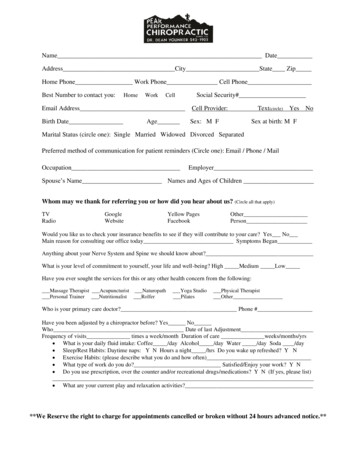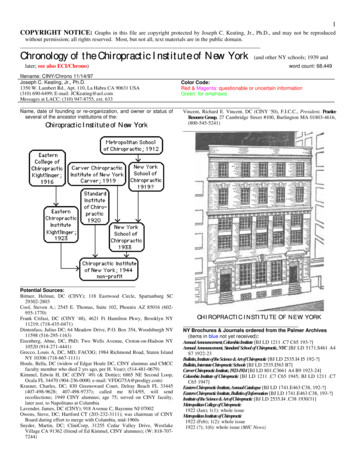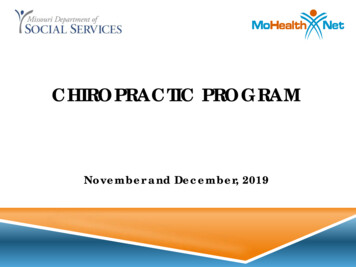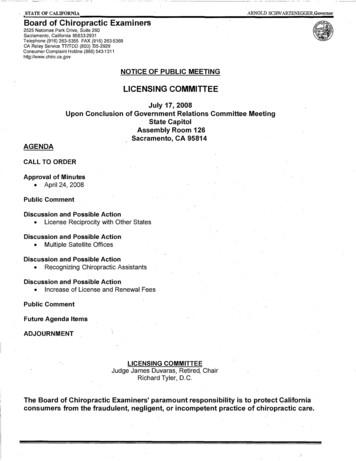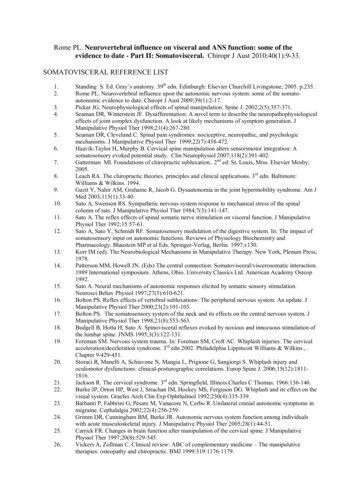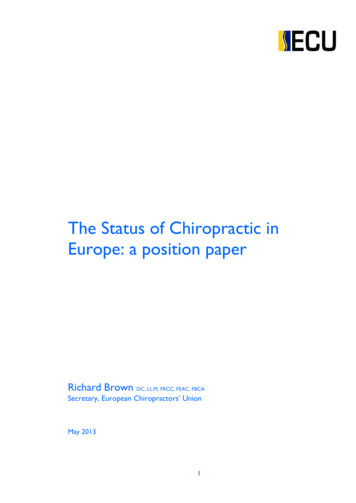
Transcription
The Status of Chiropractic inEurope: a position paperRichard Brown DC, LL.M, FRCC, FEAC, FBCASecretary, European Chiropractors’ UnionMay 20131
ContentsIntroduction3Foreword6European Chiropractors’ Union7Undergraduate education in Europe9Postgraduate education in Europe European Academy of Chiropractic11Standardisation of Chiropractic Services13Research support and promotion14Public health16Legislative and regulatory status in Europe19ECU members garyIcelandIrelandItalyLiechtensteinLuxembourgThe yUnited er non-ECU country status47Acknowledgements51Appendix 1: CEN standard: Healthcare Provision by Chiropractors522
IntroductionChiropractic is a health profession concerned with the diagnosis, treatment andprevention of mechanical disorders of the musculoskeletal system and the effect of thosedisorders on the function of the nervous system and on general health. There is anemphasis on manual treatments including manipulation or adjustment1.By restoring normal function to themusculoskeletal system chiropractors can play amajor part in relieving disorders and anyaccompanying pain or discomfort arising fromaccidents, stress, lack of exercise, poor posture,illness and everyday wear and tear.Chiropractors take a biopsychosocial approachto health and wellbeing; this means that theyconsider the physical, psychological and socialaspects of health. This approach is consistentwith the World Health Organization’s definitionof health2.Chiropractic has existed as a health profession in Europe since the early part of thetwentieth century. For over 80 years it has been represented in Europe on a supranational level by the European Chiropractors’ Union.Article 168 of the Treaty on the Functioning of the European Union3 demands that ‘a highlevel of human health protection shall be ensured in the definition and implementation of allUnion policies and activities’. It further states that ‘Union action shall be directed towards1World Federation of Chiropractic definition of chiropractic, 2001The World Health Organization defines health as a state of complete physical, mental and social wellbeingand not merely the absence of disease or infirmity. Preamble to the Constitution of the World HealthOrganization as adopted by the International Health Conference, New York, 19-22 June, 1946, signed onthe 22 July 1946 by the representatives of 61 States (Official Records of the World Health Organization, no2, page 100) and entered into force on 7 April 1948. The Definition has not been amended since 1948.3Consolidated version of the Treaty on the Functioning of the European Union (1957). Official Journal ofthe European Union C115/5023
improving public health, preventing physical and mental illness and diseases, and obviatingsources of danger to physical and mental health.’Significantly, the Treaty goes on to state, ‘The Union shall encourage co-operation betweenthe Member States in the areas referred to in this Article and, if necessary, lend support to theiraction. It shall in particular encourage co-operation between the Member States to improve thecomplementarity of their services in cross border areas’.In 2007, the EU adopted a comprehensive Health Strategy4. This set out three strategicobjectives in order to meet the major challenges facing health in the EU:1. Fostering good health in an ageing Europe;2. Protecting citizens from health threats;3. Supporting dynamic health systems and new technologies.One of the key themes of the Health Strategy is to create systems to support dynamicand sustainable health systems. This necessitates actions to promote health and preventdisease throughout life.The Global Burden of Disease Study 2010 (GBD 2010)5 is the largest ever study todescribe the global distribution and causes of a wide array of major disease, injuries andhealth risk factors. Musculoskeletal conditions were shown to be the second greatestcause of disability globally. They affect over 1.7 billion people worldwide and have thefourth greatest impact on the overall health of the world population, considering bothdeath and disability. GBD 2010 showed that that low back pain is the leading cause ofdisability and that osteoarthritis is one of the fastest growing conditions.There are calls around the world for policy changes to address the growing burden ofmusculoskeletal conditions in general and spinal pain in particular. With the burden having4Together for Heath: A Strategic Approach for the EU 2008-2013. COM 2007 630 final, Brussels. Accessedat http://ec.europa.eu/health-eu/doc/whitepaper en.pdf.5Vos T, et al. Years lived with disability (YLDs) for 1160 sequelae of 289 diseases and injuries 1990-2010: asystematic analysis for the Global Burden of Disease Study 2010. The Lancet 2012 December 15; 380(9859): 2163-21964
grown by over 45% in the past 20 years, it is critical that emerging health professions suchas chiropractic are included as part of a solution to what is an endemic health concern.The provision of chiropractic care varies widely throughout Europe. While in somenations chiropractic is established and the public has access to state-reimbursed servicesfrom chiropractors, in others chiropractic is unrecognised, unregulated and marginalised.With in excess of 5000 chiropractors practising in Europe to internationally acceptedstandards of education, the profession is well placed to contribute to the health ofEuropean citizens and the promotion of musculoskeletal health.This paper sets out the status of chiropractic in Europe. It is designed to be a livingdocument, which will be updated as new developments in health policy, research,legislative frameworks and chiropractic education are introduced.5
ForewordChiropractic is represented in over 90 countries throughout the world. From relativelyprimitive beginnings, it has evolved as a profession such that there are now in excess of100,000 chiropractors worldwide.The European Chiropractors’ Union (ECU) is a federation of 20 member nationalassociations. As its President, I am proud to lead an organisation that represents thechiropractic profession on a supranational level and is committed to its development inEurope. With a focus on legislation, regulation, education and research, the ECU seeks topromote access to safe and effective chiropractic services throughout Europe.It is my vision for chiropractic to be available to all European citizens, regardless of theirability to pay. Its emergence as a profession committed to high standards of education,research and cost-effective healthcare means that in a society where musculoskeletalconditions and associated disability contribute so massively to the burden of disease,chiropractic should be included in the health systems of every European country.I hope that this position paper will help inform policy-makers and assisting them inrecognising the contribution that chiropractic can and does make to the health ofEuropeans.Øystein Ogre DCECU PresidentMay 20136
European Chiropractors’ UnionThe European Chiropractors’ Union (ECU) is a federation of 20 member nationalassociations (see Table 1).The ECU was established in 1932 by Belgium, Denmark, Great Britain and Switzerlandwith the aims of promoting and expanding chiropractic in Europe and the welfare ofpractising chiropractors. It currently represents the interests of approximately 5000chiropractors across Europe.Table 1: Member National Associations, ECUCountryNational AssociationCountryNational AssociationBelgiumBelgian Chiropractors’ UnionItalyAssociazione Italiana ChiropracticiCyprusCyprus Chiropractic AssociationLiechtensteinLiechtenstein Chiropractic AssociationFinlandFinnish Chiropractors’ ion Française ChiropractiqueNorwayNorwegian Chiropractic AssociationGermanyGerman Chiropractors’ AssociationThe NetherlandsNetherlands Chiropractic AssociationGreat BritainBritish Chiropractic AssociationPolandPolish Chiropractic AssociationGreeceHellenic Chiropractors AssociationSpainAsociacion Espanola QuiropracticaHungaryHungarian Chiropractors’ AssociationSwedenSwedish Chiropractic AssociationIcelandIcelandic Chiropractic ic Association of IrelandTurkeyTurkish Chiropractic AssociationThe General Council of the ECU ismade up of one representative fromeach of the Union members. It electsan Executive Council, whichcurrently consists of a President, twoVice-Presidents, a Secretary and aTreasurer6.The ECU is registered in theNetherlands. It maintains offices inLondon, where it employs the6Pictured is the 2012-2013 ECU Executive Council. From left: Francine Denis (second vice-president); FranzSchmid (first vice-president); Øystein Ogre (president); Richard Brown (secretary); Vasileios Gkolfinopoulos(treasurer)7
services of support staff to administer the work of the ECU and its academic arm, theEuropean Academy of Chiropractic.Mission statementThe ECU is established to promote the development of chiropractic in Europe as well asto pursue the interests of chiropractic as a science and a profession by research, teaching,publications and research activities. It represents the chiropractic profession on asupranational level.Objectives1. To secure legislation in European countries that do not currently have it;2. To harmonise legislation across Europe that conforms to and embraces the ECU’sprofessional and educational standards;3. To promote patient safety and the quality and accessibility of chiropractichealthcare in Europe;4. To support the establishment of full time, university based education programmesto Masters level that conform to the European Council on Chiropractic Education(ECCE) standards.5. To represent and defend the principles of the chiropractic profession throughoutEurope;6. To be the political representative body of the chiropractic profession within theEuropean Union;7. To support and develop a high quality programme of research within Europe.8
Undergraduate chiropractic education in EuropeThere are currently eight educational institutions providing chiropractic education inEurope. These are set out below in Table 2.The European Council on Chiropractic Education (ECCE)7 is an autonomous organisationestablished by the chiropractic profession in Europe to accredit and re-accreditinstitutions providing undergraduate education and training. The principal goal of theECCE is to assure the quality of chiropractic undergraduate education and training againsta set of educational standards. Its current President is Tim Raven (pictured below).The Standards are intended for use by chiropracticinstitutions, both in the public university and privatesectors, predominately (but not exclusively) in Europe, aspart of institutional self-evaluation, by the ECCE forexternal review of institutions and by internationalcommittees and bodies involved in the recognition andaccreditation of chiropractic institutions worldwide.Once an institution has demonstrated that it is insubstantial compliance with the Standards and has graduated its first cohort of students,the institution is accredited for up to five years. Prior to full accreditation an institutionmay apply for candidate (for accredited) status; the maximum period an institution canhold candidate status is five years.The ECCE is, together with the US, Canadian and Australasian Councils on ChiropracticEducation (CCEs), a founding member of the Councils on Chiropractic EducationInternational (CCEI)8. It is the only external quality assurance agency for chiropracticeducation and training in Europe that is a member of CCEI and recognised by the7European Council on Chiropractic Education (ECCE). Accessed at www.cce-europe.comInternational accreditation standards published by CCEI can be accessed athttp://www.cceintl.org/uploads/2010-0426 CCEI International Chiropractic Accreditation Standards vfd 5 09.pdf89
chiropractic profession and other CCEs world-wide, and that adheres to the CCEIInternational Chiropractic Accreditation Standards.The ECCE is a member of the European Association for Quality Assurance in HigherEducation (ENQA) and adheres to the Standards and Guidelines for Quality Assurance inthe European Higher Education Area9 (ESG).Table 2: Educational institutions in EuropeInstitutionLocationWebsiteECCE status?Anglo-European College of ChiropracticBournemouth, UKwww.aecc.ac.ukFullBarcelona College of ChiropracticBarcelona, Spainwww.bccchiropractic.esCandidateInstitut Franco-Europeen de Chiropractique FrancaiseParis, Francewww.ifec.netFullMcTimoney College of ChiropracticAbingdon, UKwww.mctimoney-college.ac.ukCandidateRCU Escorial Maria CristinaMadrid, Spainwww.rcumariacristina.comFullSyddansk Universitet OdenseOdense, Denmarkwww.sdu.dkFullWelsh Institute of ChiropracticGlamorgan, UKwww.glam.ac.ukFullUniversity of ZurichZurich, Switzerlandwww.balgrist.chNoAlthough not currently accredited with ECCE, in Switzerland, chiropractic students trainalongside medical students and undertake a six year programme of study. The programmeand award is recognised within the Swiss Federal Law on medical professions (MedBG).The World Health Organization has published Guidelineson Basic Training and Safety in Chiropractic10. Part I ofthe guidelines covers basic requirements for differenttraining programmes, each one designed for trainees withvarious educational backgrounds, including non-medics,physicians wishing to use chiropractic and primary healthcare workers. This part provides a reference for theestablishment of various training programmes,particularly where no formal education degree has beenestablished. Part II of the guidelines deals with the safety of spinal manipulative therapyand the contraindications to its use.9ENQA. Standards and Guidelines for Quality Assurance in the European Higher Education Area (2009)Helsinki. Accessed at http://www.enqa.eu/files/ESG 3edition%20(2).pdf.10WHO Guidelines on Basic Training and Safety in Chiropractic. Accessed 6e/s14076e.pdf10
Postgraduate chiropractic education in EuropeEach year the ECU hosts a scientificconvention which attracts delegatesfrom throughout Europe and the restof the world. This event is a highlightin the European academic calendar andbrings together chiropractors fromeach of the ECU’s 20 member nations.The ECU actively promotes postgraduate chiropractic education (Graduate EducationProgrammes and continuing professional development) in Europe through the EuropeanAcademy of Chiropractic (EAC). It aims to expose chiropractors to current best practice,by stimulating reflective learning and by acting as a conduit for research activity. In doingso, the EAC contributes to the facilitation of safe, evidence-based and optimum standardsof care.The EAC hosts post-graduate seminars throughout Europe aswell as an annual Graduate Education Programme seminar.The Dean of the EAC is Martin Wangler (pictured). He heads aGoverning Council comprising a Dean, Registrar, Director ofAcademic Affairs, Secretary General, Chair of the ECUResearch Council, ECU Convention Academic Organiser andECU President.The objects of the EAC are as follows:1. To develop key professional competencies through lifelong learning;2. To provide and co-ordinate access to high quality sources of knowledge and skills;3. To encourage and actively support the acquisition by chiropractors of higher levelpostgraduate qualifications and EAC Fellowship awards;11
4. To facilitate the formation and development of Graduate Education Programmes(GEP) by national associations;5. To provide a platform to bring together parties with a diversity of experience andexpertise to enable the sharing of best practice;6. To raise quality standards across the profession and enhance chiropractic’scontribution to a healthier society by facilitating a collaboration of Europeannational chiropractic associations, educational institutions, researchers andpostgraduate educational providers.With the Chiropractic and Osteopathic College of Australasia and the Royal College ofChiropractors, the EAC co-owns the online peer-reviewed journal Chiropractic andManual Therapies.This high quality online journal aims to providechiropractors, manual therapists and relatedhealth professionals with clinically- relevant,evidence-based information. All articles published by Chiropractic and Manual Therapies aremade freely and permanently accessible immediately upon publication withoutsubscription charges or registration barriers.There are also a number of other post graduate educational organisations in Europe.These include the Royal College of Chiropractors (UK), the National Institute forChiropractic and Clinical Biomechanics (Denmark) and the Swiss Chiropractic Academy.12
Standardisation of Chiropractic ServicesA European Standard (EN) is a standard that has been adopted by one of the threerecognised European Standardisation Organisations: CEN, CENELEC and ETSI. It isproduced by all interested parties through an open, transparent and consensus basedprocess.European Standards are one of the key components of the Single European Market. Astandard represents a model specification, a technical solution against which a market cantrade. It codifies best practice and the state of the art.Chiropractic was the first health profession to be subject to a European Standard. In2012, following three years of preparation and the consensus of the chiropracticprofession in Europe, the Standard for Healthcare Provision by Chiropractors waspublished. The reference for this Standard is EN 16224:2012.This CEN Standard is a landmark document. It sets out what thepublic should expect from a chiropractor: educationally,professionally and ethically. Importantly, it acts as a guide to thosecountries seeking statutory recognition and acts as a modeltemplate for legislators.The ECU has adopted the CEN Standard for Healthcare Provision by Chiropractors andhas incorporated its Code of Ethics as a dedicated ECU Code of Good Practice11.The ECU encourages formal adoption of the Standard by each of its member nationalassociations. It is particularly important that this is the case in countries withoutchiropractic legislation, so that the Standard can become the default guideline forhealthcare provision by chiropractors.11ECU Code of Good Practice. Accessed at %20Documents/Code%20of%20Good%20Practice-ECU.pdf13
ECU Research Support and PromotionThe promotion of research is a core objective of the ECU. Of each per capita fee that isreceived by the ECU, a proportion is ring-fenced to fund research. The Chair of the ECUResearch Council is Dr Sidney Rubinstein PhD (pictured). He sits as a permanentobserver at meetings of the ECU General Council andholds a position as a member of the Governing Council ofthe European Academy of Chiropractic.The purpose of the European Chiropractors' UnionResearch Council is to promote and support scientificresearch which will improve the knowledge,understanding and practice of chiropractic. Pursuant to adirective ratified by the ECU General Council, theResearch Fund is administered by the ECU ResearchCouncil. It ensures that correctly submitted applicationsfor research funding have been properly scrutinised and considered prior to formallycommunicating any recommendations to the ECU General Council.Each year at its Convention, the ECU hosts a Researchers’ Day. This unique event bringstogether chiropractic researchers from across Europe to discuss ongoing projects,identify areas for future research and to share best practice.The ECU supports a wide range of projects, granting in excess of 100,000 per year.These include multi-centre trials, PhD projects, systematic reviews and other innovativeresearch.Table 3 below shows examples of ongoing projects being supported by the ECU ResearchFund:14
Table 3: Projects currently supported by the ECU Research FundProject titleResearcher(s)Object of studyMorphology and age-related osteoarthriticchanges in cervical spineUhrenholt LTo investigate characteristics of lowercervical facet joints in subjects aged 20-79Descriptive study on maintenancechiropractic care on persistent andrecurrent LBP patientsJensen I, Axen ITo describe long term course of patientswho have been defined by chiropractorsto be suitable for maintenance care.The relative impact of biopsychosocialfactors as predictors of outcomes inpatients treated by chiropractors for neckand low back pain.Ailliet ATo examine the relative contribution ofthe biopsychosocial model in predicting apoor outcome in patients undergoingchiropractic care for neck and/or low backpain.The effects of manipulation on cervicalspine intervertebral motion patterns andpatient reported outcomes.Breen A, Bolton J, Bronfort G, Branney JTo investigate whether spinal manipulationcan improve or normalise aberrantvertebral motion in patients with chronicmechanical neck pain.Outcomes after chiropractic treatment forpatients with low back pain with andwithout leg pain or neck pain with orwithout arm pain.Humphreys K, Peterson C, Muhlemann D,Bolton JTo investigate how different subgroups ofpatients with LBP or neck pain respond tochiropractic at various time intervals.Magnetic resonance imaging of thesynovial folds of the lateral atlantoaxialjoints following whiplash injuryWebb A, Dareker, SampsonTo determine whether changes in the sizeand signal intensity of the synovial folds ofthe lateral atlantoaxial joints are presentto a greater extent in patients withwhiplash associated disorder compared tohealthy control subjects.Normal biomechanics of the lumbar spine– a quantitative fluoroscopy andelectromyography studyBreen A, du Rose ATo determine the normal numericalreference limits and relationships betweenintervertebral motion patterns, erectorspinal muscle electrical activity, age anddegree of disc degeneration during lateralbending in the lumbar spine and whetherchiropractic motion palpation can detectvariations.Evaluation of costs and outcomes in lowback patients undergoing chiropractic andgeneral practitioner care in Switzerland.Houweling T, Humphreys KTo investigate the costs, cost-utility andoutcomes in low back pain patientsundergoing routine chiropractic andgeneral practitioner care.Towards measuring the spinal manipulablelesion: comparing neck function in patientswithout neck pain to those with neck painbefore and after HVLA manipulationOsborne N, Docherty STo investigate whether there is anydifference in function between neck painpatients, before and immediately afterspinal manipulation compared to a controlgroup.Establishing a research agenda forchiropractic in Europe.Rubinstein S, Hartvigsen J, Bolton J, WebbA, van Tulder MTo establish a research agenda for thechiropractic profession in Europe throughconsensus involving a Delphi process.In 2012, the General Council approved a proposal from the Executive Council tofinancially support the establishment of national chiropractic research foundations in theform of a start-up grant. Financial support has already been granted to the membernational chiropractic associations of Norway, France, Sweden and Great Britain. This willboth stimulate the growth of research activity and develop the body of knowledge, thusbenefiting patients, the public and society.15
Public HealthThe ECU is committed to contributing to public health in Europe. It recognises the valueof healthy populations in determining the economic prosperity of nations, labour supplyand public spending. It fully supports the European Commission’s commitment toinvesting in health to contribute towards the Europe 2020 objective of smart, sustainableand inclusive growth.The ECU recognises that in the field of musculoskeletal health there remain inequalitiesacross Europe in terms of access to effective care. Poor and disadvantaged people dieyounger and suffer more from disability and disease. The ECU is committed to expandingthe availability and accessibility to chiropractors throughout EU and EEA member nations.With spending on health outstripping GDP growth, to the extent where it is estimatedthat it will have risen by a third by 2060, there is a need to transform health systems12.The ECU maintains that the chiropractic profession should be part of this transformation.It has a dedicated Public Health Committee (PHC), whose terms of reference are asfollows:a. To be responsible for advising the General Council on public health matters asthey relate to chiropractic in general and spine care in particular.b. To be responsible for advising the General Council on ways in which the ECUcan (i) work on public health projects and (ii) forge alliances with otherorganisations in support of common health objectives.c. To be responsible for the development, maintenance, review anddissemination of an ECU public health toolkit, which outlines a strategiccourse for chiropractic’s active involvement in programmes, including the12Brown RA. A health system in transformation: making the case for chiropractic. Chiropractic and ManTherapies 2012, 20: 37 doi:10.1186/2045-709X-20-3716
identification of key public health priorities, advocacy opportunities andoperational strategies for the improvement of health.d. To collaborate with other committees of the ECU as appropriate for thefurtherance of the ECU’s objects.The ECU Public Health Committee is chaired by BaijuKhanchandani (pictured). He is supported by committeemembers from across Europe.There are a number of current areas of interest, includingensuring that there is recognition for chiropractors in aEuropean classification of occupations (ESCO).The ECU is a member of the European Public Health Alliance (EPHA)13, the leadingEuropean non-governmental organisation (NGO) advocating for better health. EPHA is anon-profit organisation which is based in Belgium and includes public health NGOs,patient groups, health professionals and disease groups working to improve health andstrengthen the voice of public health in Europe.EPHA monitors the policy-making process within the EU institutions and supports theflow of information on health promotion and public health policy developments.The ECU is an associate body of SOLVIT14, a Department of the European Commission.SOLVIT is an online problem-solving network in which EU Member States work togetherto solve issues relating to misapplication of Internal Market law within the EU and EEA.One example of a successful European public health initiative has been the Straighten Upcampaign. The Straighten Up program is a bold and innovative health promotion initiativedesigned to empower the people everywhere toward better spinal health and animproved quality of life.13European Public Health Alliance. Accessed at http://www.epha.org14SOLVIT. Accessed at http://ec.europa.eu/solvit/site/about/index en.htm17
Consisting of a set of simple exercises and taking just minutes to complete, Straighten Uphelps improve posture, stabilise core muscle groups, enhance health and prevent spinaldisability. It can be completed quite briefly as a regular day-to-day practice. The 2-3minute routine can counter poor posture, which is a common trigger for general backpain and can be undertaken by all ages.Studies undertaken have shown that after adopting the routine each day over a five weekperiod, the posture of participants (who ranged in age from teenagers to those in theireighties) improved in eighty per cent of cases. Another 78% reported that they hadstrengthened their core muscles, whilst 80% reported that they sat and stood moreupright whilst saying that their backs felt more comfortable.The ECU contributes to a number of Europe-wide public health consultations. These aresummarised in Table 4 below.Table 4: ECU participation in European public health consultationsDate of responsePublic consultation on the implementation of European Reference Networks (ERN) under the framework ofDirective 2011/24/EU on the application of patients’ rights in cross border healthcare.2013Consultation on EU VAT Exemption2013EU Small and Medium Enterprise consultation2012WHO-Europe Health 2020 Questions2012Green Paper on modernising the Professional Qualifications Directive2011EU VAT Consultation2011EU Recognition of Professional Qualifications2011Competitiveness and Innovation Framework Programme2011EU Single Market consultation2011Green Paper on the European Workforce for Health2009EU DG SANCO, Future Challenges Consultation2008EU Health Portal Reply2007EU White Paper, Sports, Survey Reply2007EU Telemedicine Survey2007EU Community Action Survey200718
Legislative and Regulatory Status of Chiropractic inEuropeThere is wide variation between the legislative and regulatory status of chiropractic inEurope. This inequality creates issues for both patients and practising chiropractors.Table 5 (below) shows the current status of chiropractic within Europe15, while Figure 1displays the status on a geographical level.What is clear is that chiropractic can be practised legally in many EU member nations,either pursuant to specific legislation or pursuant to general law. In countries that benefitfrom dedicated legislation, there is statutory registration and protection of title. Thisserves to protect patients and assure the public that those using the title chiropractorsatisfy set standards of competency and education.It is one of the ECU’s primary objectives to promote the statutory regulation ofchiropractors throughout Europe. The successful completion of the CEN Standard forHealthcare Provision by Chiropractors sets in place a template for those countriesseeking legislation.The existence of Masters level programmes of study, offered by educational institutionsaccredited by the European Council on Chiropractic
The European Council on Chiropractic Education (ECCE)7 is an autonomous organisation established by the chiropractic profession in Europe to accredit and re-accredit institutions providing undergraduate education and training. The principal goal of the ECCE is to assure the quality of chiropractic undergraduate education and training against


